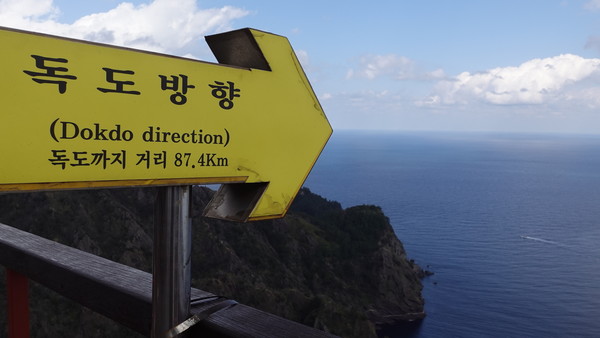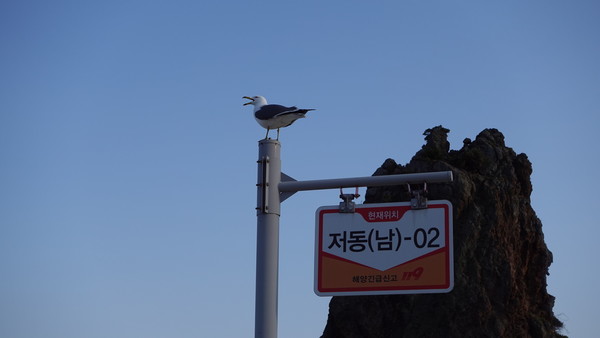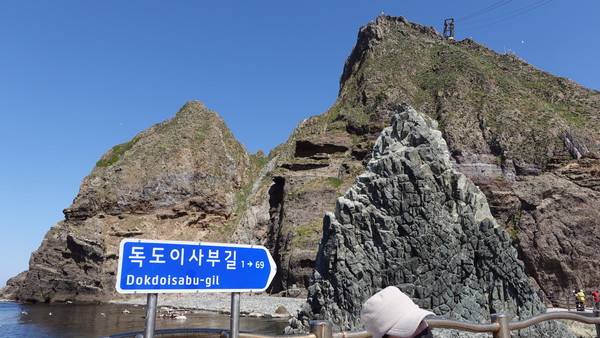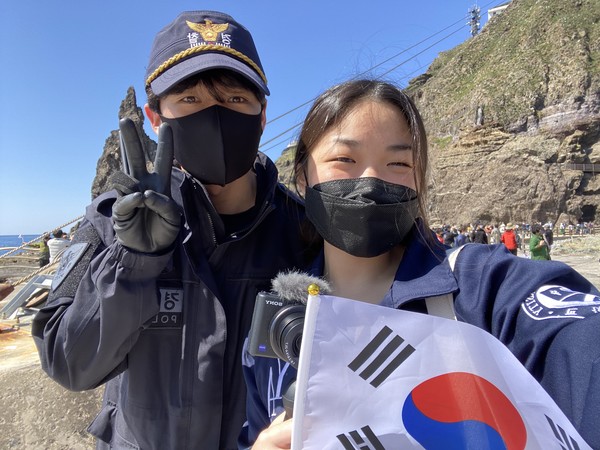Korean territory, Korean people, and Korean nature

DOKDO IS a volcanic island home to hundreds of flora and fauna, as well as a controversial piece of land that has been the subject of long-running territorial disputes between South Korea and Japan. It is common for South Korean students—like myself—to have grown up reading history books, singing songs, and writing essays describing why Dokdo rightfully belongs to South Korea. Keeping in mind that it is a “Korean's duty to visit Dokdo at least once in their lifetime,” I headed to the island with my pad, pencil, and camera.
The “disputed” territory
Located at the eastern endpoint of the Korean peninsula, Dokdo consists of two main islands, Dongdo and Seodo, and 89 smaller islets. Home to a vast variety of plant, bird, insect, and fish species, the island is preserved as Korea's Natural Monument No. 336[1]. In addition to its ecological and historic value, Dokdo also has massive amounts of mineral resources, such as natural gas hydrates worth about ₩300 trillion. Currently, Dokdo is home to approximately 34 Korean residents and protected by Korean Police Guards.
Unfortunately, Dokdo has long been the subject of intense diplomatic disputes between South Korea and Japan. The oldest surviving record of Ulleung-do and Dokdo published in 512 A.D. reveals that these islands were the territory of Silla, an ancient Korean kingdom[2]. Historical documents and maps produced by third-party countries such as the United States, France, and Russia also mark Dokdo as Korean territory. Similar, tangible records affirm Korean territorial rights over Dokdo until the period of Japanese colonial rule. Yet, since 1905, Imperial Japan attempted to annex Dokdo through unlawful documents and aggressive lobbying. In 2006, the Japanese Shimane prefectural government went so far as to create their own holiday commemorating the island[3]. The Korean government continues to maintain a firm stance on Dokdo’s ownership: “Dokdo is an integral part of Korean territory, historically, geographically and under international law. No territorial dispute exists regarding Dokdo, and therefore Dokdo is not a matter to be dealt with through diplomatic negotiations or judicial settlement[4].”

Stopping by beautiful Ulleung-do
Traveling to Dokdo is a little more difficult than most trips. With no direct flight or boat ride taking passengers to the island, visitors can only enter Dokdo through Ulleung-do, the island nearest to Dokdo. For the trip, I departed from Seoul station, took the KTX train from Seoul to Gangneung-si, boarded a ferry from Gangneung Port to Ulleung-do, and then boarded another ferry from Ulleung-do to Dokdo. The money spent on transportation alone totaled ₩251,100: ₩55,200 for KTX train tickets, ₩133,900 for Ulleung-do ferry tickets, and ₩62,000 for the Dokdo round-trip ferry ticket. In addition to the transportation hurdles, boat operation times and travel availability are up to frequent change. In a phone call I made before the trip, a representative from the Ulleung-gun office told me that the chances of a ferry anchoring in Dokdo are around 30%, depending on the weather and sea conditions. On days with bad weather, the ferry simply circles Dokdo and visitors are not allowed to step foot on the island.
To increase my chances of entering Dokdo, I stayed in Ulleung-do for an entire weekend. During that time, I explored the Dokdo Museum, where visitors can view important documents, objects, and videos attesting Korea’s sovereignty over the island. Afterward, I rode the Dokdo Island Observatory Cable Car adjacent to the museum and got a scenic, bird's eye view of the volcanic islands. My tip here would be to buy the cable car snack shop owner’s handmade pumpkin sik-hye, a traditional sweet Korean rice beverage; it was so flavorful that I guzzled two drinks in one sitting.
The hotel I stayed at was located in Jeo-dong Port, the biggest port in Ulleung-do. Arriving at Jeo-dong, I was met with boats lined up on the harbor, fishermen preparing the fish they had caught, and restaurants serving meals made from fresh, local seafood. There were also strings of souvenir shops selling the local specialties of Ulleung-do, such as pumpkin yeot[5] and other pumpkin-based products, dried squid, and seaweed. Aside from standard tourist information also available on Google, what stood out to me most was the staggering warmth of the locals in Ulleung-do. I had been accustomed to Seoul where jeong, a broad term used to describe the Korean culture of love and affection shared between people, was increasingly difficult to feel. However, spending a few days in Ulleung-do, I was astounded by the unconditional friendliness and generosity offered by every single person I encountered. Not a single local showed even the slightest sign of frustration when stopped by tourists asking for directions, places to visit, or restaurants to eat at. After finding out that I was traveling by foot on an island where finding suitable transportation is difficult, some would personally walk me to places they liked, and one local even gave me a map of notable destinations in Ulleung-do. By the end of my trip, I had made friends with two high school students while walking along the seaside, a taxi driver I talked to during his smoke break, and a handful of shop owners who remembered the student journalist running around with her camera for 3 consecutive days.

Arriving at Dokdo: only 20 minutes per boat
I had been lucky to choose a weekend with sunny weather and calm ocean currents; I was able to step foot on Dokdo on my first try. Along with money for the round-trip ferry ticket and snacks to eat on the boat, I suggest bringing an additional ₩2,500: ₩1,500 for seasickness-prevention medication and ₩1,000 for a portable Korean flag, both sold in shops near the ticket booth. The entire trip takes around 4 hours, with approximately 3 hours spent traveling from Ulleung-do to Dokdo and back, and only 20 minutes allowed per boat for visitors to explore Dokdo. The area open to tourists has a limited view of the two main islands and some of the surrounding islets. I could see the famous Dokdo Isabu-gil, the street named after the military general of Silla who helped incorporate the island into Korean territory, less than a minute into my tour. Walking down the street, it was refreshing seeing the April sunlight crash against the clear ocean water to create an iridescent emerald hue, breathing in the unadulterated ocean air, and observing Dokdo’s various plant and animal species interact right in front of my eyes. Some tourists had even brought shrimp-flavored crackers to feed the black-tailed gulls, a bird species often found on the shorelines of Korea. However, I could not help but notice the bulk of the visitors focused more on taking photos of themselves on the island, rather than stopping to really observe and appreciate the beautiful scenery. I myself regret being too occupied with filming the view and suggest that prospective visitors allocate some of their 20-minute tours to put the cameras away and simply walk around, as difficult as that may be.


* * *
Unlike Jeju Island or Busan, Ulleung-do and Dokdo are not typical Korean travel destinations loaded with scores of tourist-friendly shops and facilities; both islands are still largely (and thankfully) free from gentrification or industrialization. Traveling to the island from Seoul requires a significant amount of time, dedication, luck, and energy. Despite the unique challenges, however, you will grow and soften during the experience. Briefly pausing my Seoul student life of juggling classes, part-time jobs, and worrying about the future, the trip reminded me of how long it had been since I stopped to catch my breath and take a break.
[1] Ministry of Foreign Affairs
[2] Dokdo Museum
[3] Dokdo Museum
[4] Ministry of Foreign Affairs
[5] Yeot: Korean sweet taffy

